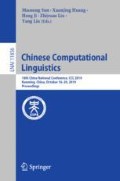Abstract
Natural Language Inference (NLI), which is also known as Recognizing Textual Entailment (RTE), aims to identify the logical relationship between a premise and a hypothesis. In this paper, a DCAE (Directly-Conditional-Attention-Encoding) feature based on Bi-LSTM and a new architecture named LIC (LSTM-Interaction-CNN) is proposed to deal with the NLI task. In the proposed algorithm, Bi-LSTM layers are used to modeling sentences to obtain a DCAE feature, then the DCAE feature is reconstructed into images through an interaction layer to enrich the relevant information and make it possible to be dealt with convolutional layers, finally the CNN layers are applied to extract high-level relevant features and relation patterns and the discriminant result obtained through a MLP (Multi-Layer Perceptron). Advantages of LSTM layers in sequence information processing and CNN layers in feature extraction are fully combined in this proposed algorithm. Experiments show this model achieving state-of-the-art results on the SNLI and Multi-NLI datasets.
Access this chapter
Tax calculation will be finalised at checkout
Purchases are for personal use only
References
Dagan, I., Glickman, O.: Probabilistic textual entailment: generic applied modeling of language variability. Learn. Methods Text Underst. Min. 2004, 26–29 (2004)
Bowman, S.R., Angeli, G., Potts, C., Manning, C.D.: A large annotated corpus for learning natural language inference. In: Proceedings of the 2015 Conference on Empirical Methods in Natural Language Processing, pp. 632–642 (2015)
Williams, A., Nangia, N., Bowman, S.: A broad-coverage challenge corpus for sentence understanding through inference. In: Proceedings of the 2018 Conference of the North American Chapter of the Association for Computational Linguistics: Human Language Technologies, Volume 1 (Long Papers), pp. 1112–1122 (2018)
Tay, Y., Luu, A.T., Hui, S.C.: Compare, compress and propagate: enhancing neural architectures with alignment factorization for natural language inference. In: Proceedings of the 2018 Conference on Empirical Methods in Natural Language Processing, pp. 1565–1575 (2018)
Ghaeini, R., et al.: DR-BiLSTM: dependent reading bidirectional LSTM for natural language inference. In: Proceedings of the 2018 Conference of the North American Chapter of the Association for Computational Linguistics: Human Language Technologies, Volume 1 (Long Papers), pp. 1460–1469 (2018)
Gong, Y., Luo, H., Zhang, J.: Natural language inference over interaction space. arXiv preprint arXiv:1709.04348 (2017)
Liu, Y., Sun, C., Lin, L., Wang, X.: Learning natural language inference using bidirectional lstm model and inner-attention. arXiv preprint arXiv:1605.09090 (2016)
Wang, S., Jiang, J.: Learning natural language inference with LSTM. In: Proceedings of NAACL-HLT, pp. 1442–1451 (2016)
Chen, Q., Zhu, X., Ling, Z.H., Wei, S., Jiang, H., Inkpen, D.: Enhanced LSTM for natural language inference. In: Proceedings of the 55th Annual Meeting of the Association for Computational Linguistics (Volume 1: Long Papers), pp. 1657– 1668 (2017)
Pang, L., Lan, Y., Guo, J., Xu, J., Wan, S., Cheng, X.: Text matching as image recognition. In: Proceedings of the Thirtieth AAAI Conference on Artificial Intelligence, pp. 2793–2799. AAAI Press (2016)
Rocktäschel, T., Grefenstette, E., Hermann, K.M., Kočiský, T., Blunsom, P.: Reasoning about entailment with neural attention. arXiv preprint arXiv:1509.06664 (2015)
Cheng, J., Dong, L., Lapata, M.: Long short-term memory-networks for machine reading. In: Proceedings of the 2016 Conference on Empirical Methods in Natural Language Processing, pp. 551–561 (2016)
Plummer, B.A., Wang, L., Cervantes, C.M., Caicedo, J.C., Hockenmaier, J., Lazebnik, S.: Flickr30k entities: collecting region-to-phrase correspondences for richer image-to-sentence models. In: Proceedings of the IEEE International Conference on Computer Vision, pp. 2641–2649 (2015)
Pennington, J., Socher, R., Manning, C.: GloVe: global vectors for word representation. In: Proceedings of the 2014 Conference on Empirical Methods in Natural Language Processing (EMNLP), pp. 1532–1543 (2014)
Srivastava, N., Hinton, G., Krizhevsky, A., Sutskever, I., Salakhutdinov, R.: Dropout: a simple way to prevent neural networks from overfitting. J. Mach. Learn. Res. 15(1), 1929–1958 (2014)
Chen, Q., Zhu, X., Ling, Z.H., Wei, S., Jiang, H., Inkpen, D.: Recurrent neural network-based sentence encoder with gated attention for natural language inference. In: Proceedings of the 2nd Workshop on Evaluating Vector Space Representations for NLP, pp. 36–40 (2017)
Pan, B., Yang, Y., Zhao, Z., Zhuang, Y., Cai, D., He, X.: Discourse marker augmented network with reinforcement learning for natural language inference. In: Proceedings of the 56th Annual Meeting of the Association for Computational Linguistics (Volume 1: Long Papers), pp. 989–999 (2018)
Acknowledgements
This work is funded by National Key Research and Development Projects of China (2018YFC0830703). It is also supported by National Natural Science Foundation of China (Grant No. 61572320 & 61572321).
Author information
Authors and Affiliations
Corresponding author
Editor information
Editors and Affiliations
Rights and permissions
Copyright information
© 2019 Springer Nature Switzerland AG
About this paper
Cite this paper
Hu, J., Sun, T., Jiang, X., Yao, L., Xu, K. (2019). Natural Language Inference Based on the LIC Architecture with DCAE Feature. In: Sun, M., Huang, X., Ji, H., Liu, Z., Liu, Y. (eds) Chinese Computational Linguistics. CCL 2019. Lecture Notes in Computer Science(), vol 11856. Springer, Cham. https://doi.org/10.1007/978-3-030-32381-3_47
Download citation
DOI: https://doi.org/10.1007/978-3-030-32381-3_47
Published:
Publisher Name: Springer, Cham
Print ISBN: 978-3-030-32380-6
Online ISBN: 978-3-030-32381-3
eBook Packages: Computer ScienceComputer Science (R0)

